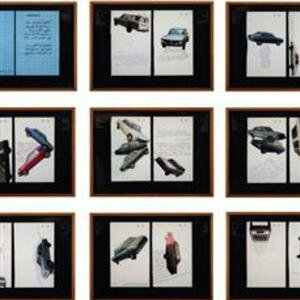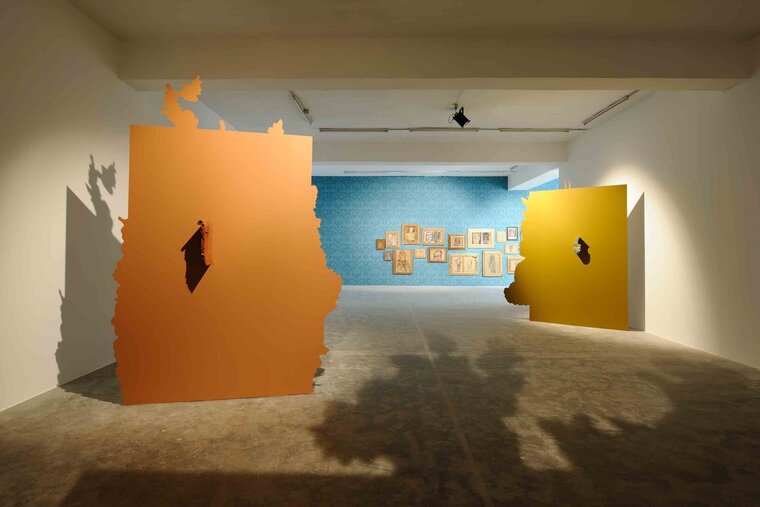


Last updated on Thu 31 August, 2017


WALID RAAD
Better Be Watching the Clouds
August 31, 2017 - December 30, 2017
The exhibition debuts some of Raad's new works from three ongoing art projects:
The Atlas Group (1989-2004) is a fifteen-year project that engages the Lebanese wars of the past few decades. Raad follows an artistic and investigative process that leads to the production of various documents (notebooks, photographs, videos). Better be watching the clouds can be described as The most important thing in the history of the world is the fact that the country is not the only country in the world. Raad portrays political and military leaders by Lebanon's security services.
Raad Initiated Scratching on Things I Could Disavow in Abu Dhabi, Beirut, Doha, and others in 2007 at the same time that the building of new infrastructures for the arts (museums, galleries, schools, etc.). These material developments were "Islamic," "modern," and "contemporary." The three artworks presented, Les Louvres, Preface to the ninth edition: On Marwan Kassab Bachi, and Letters to the Reader. Raad's artworks with this project are attributed to the cultural artifacts. In Les Louvres, We confront artifacts that are "exchanged faces." In letters to the reader, artworks lose their shadows. And with Preface to the ninth edition: On Marwan Kassab Bachi (1934-2016), paintings on the backs of other paintings.
The exhibition also includes a series of large-scale photographs from the Sweet Talk: Beirut (Commissions) project. In the late 1980s, Raad committed himself to photographing the city of Beirut, referring to the various self-assignments as "Commissions." Sweet talk focuses on Beirut's residents as well as its buildings, streets, storefronts, gardens, monuments, and other objects, situations, and spaces in the city. In the exhibition, Raad presents six photographs of various "scenes" he encountered in Beirut in the early 1990's, and two photographs from his ongoing "public monuments" series.
The exhibition also presents the following: A portrait of a Beirut Site Museum: Preface (2016-2026), a recent collaboration with architect Bernard Khoury.
Born in 1967 in Lebanon, Walid Raad is Professor of Art at The Cooper Union (New York, USA). (2015), Museo Jumex Arte Contemporaneo (2016), Museo MADRE Napoli (2015), Carré d'Art, Musée d'Art contemporain, Nîmes (2014), Louvre, Paris (2013), Kunsthalle Zurich (2010), and The Whitechapel Art Gallery, London (2010). Raad is also the recipient of numerous awards, among which the Hasselblad Award (2011), the Alpert Award in Visual Arts (2007), the Deutsche Börse Photography Prize (2007), and the Camera Austria Award (2005).
The plates were donated in 1992 to The Atlas Group by Fadwa Hassoun, a retired officer in the Lebanese Army.
Throughout the 1970s and 1980s, Lebanon’s Deuxième Bureau code-named local and international political and military leaders in the language of local flora. As a trained botanist, Hassoun’s job was to assign the code names to the leaders. Hassoun kept track of all code names in a logbook where she collaged faces of the leaders onto flowers and trees. The plant’s name became the politician’s code name. As such, Hosni Mubarak became Dwarf Mallow; Mikhail Gorbachev, Purple Carline; Ronald Reagan, Kermes Oak; And Kamal Joumblatt, Pink Sorrell.
Of the 18,000 objects held in the Louvre’s newly established département des Arts de l’Islam, 300 were sent to the Louvre Abu Dhabi in 2013 for the museum’s 2017 inaugural exhibition.
When the crates were opened in Abu Dhabi in the summer of 2013, the French conservators, expressly own in from Paris for the delicate operation, were taken aback by what was inside. e objects that had arrived were not the ones that had been sent. At first, it was thought that the French conservators, unused to the Emirati heat, were experiencing hallucinations. Locals were solicited. They not only confirmed the “changes” reported by the French conservators but also proposed that the objects had “suffered chemically” when the climate-controlled crates were opened in the Arabian Desert. They proposed that it was the objects, rather than the conservators, who were affected by the heat. Both scenarios seemed unconvincing to me.
As an artist-in-residence in the Louvre at the time, I requested and was granted permission to examine the objects. I proceeded over the following two years to submit them to various aesthetic experiments, two of which yielded unusual findings.
I filtered the objects through color shapes whose outlines and colors matched the silhouettes of some Persian miniature paintings. is produced a momentous revelation. The affected object’s face seemed to reveal another’s behind it. Hundreds of masks and colors later, I was able to confirm that each object was a composite of at least two others.
I’d noticed during my first experiment, that the affected objects curiously lacked shadows. No amount or quality of light brought out the shadows. A fortuitous accident guided my second experiment. Only when I painted a shadow on a specifically colored wall next to an object, did its own manifest.
The above experiments led me to conclude that the objects had in fact traded faces with each other, and that the face-trade resulted in a shadow-less object.
While visiting the recently opened Museum of Modern Art in Beirut, I noticed with great surprise that most paintings on display had no shadows. At first I was beside myself, convinced that religious zealots had destroyed the shadows. But there was no debris. I pondered anxiously whether the shadows had lost their bearings or grip. I suppose I should have known all along that the shadows were neither destroyed nor lost: they had simply lost interest in the walls where they were made to hang. I decided to build new walls on which I carved shadow-like forms (magnets of sorts) in the hope they’d attract the restless shadows. Thus far, not a single catch.
Marwan Kassab-Bachi, one of the most prolific Arab painters, has never exhibited in Beirut’s National Museum. Yet twenty-three of his drawings and paintings were found on the back of framed artworks in the museum’s storage. It remains unclear whether these were drawn by Marwan himself or an anonymous friend, admirer, backer, critic, defamer, or other.
In Preface (2016-2026), Raad and Khoury present their (non-winning) submission to the architectural competition initiated by the Lebanese association, APPEAL, to design the Beirut Museum of Art (BeMA).
Join us in our endless discovery of modern and contemporary Arab art